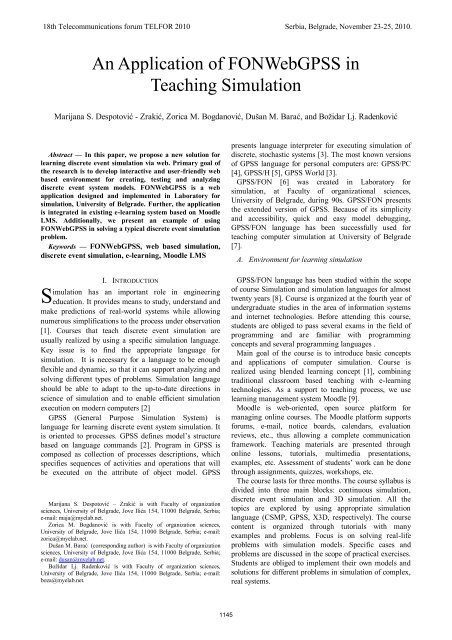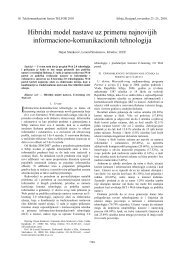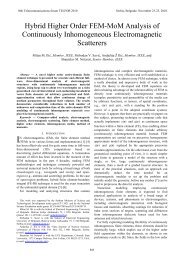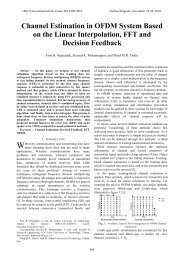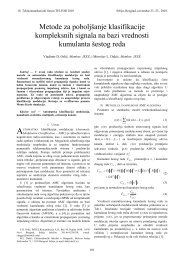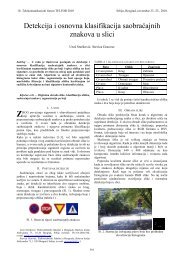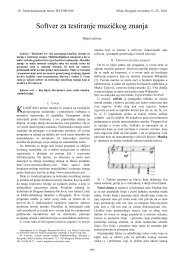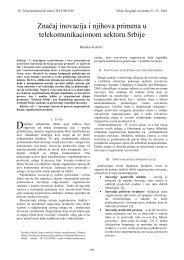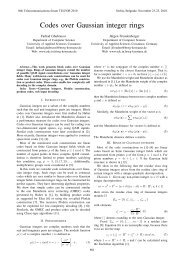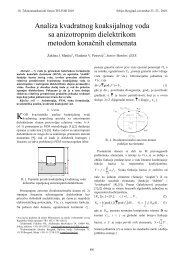TELFOR 2006 - 18. telekomunikacioni forum TELFOR 2010 - Telfor
TELFOR 2006 - 18. telekomunikacioni forum TELFOR 2010 - Telfor
TELFOR 2006 - 18. telekomunikacioni forum TELFOR 2010 - Telfor
You also want an ePaper? Increase the reach of your titles
YUMPU automatically turns print PDFs into web optimized ePapers that Google loves.
18th Telecommunications <strong>forum</strong> <strong>TELFOR</strong> <strong>2010</strong> Serbia, Belgrade, November 23-25, <strong>2010</strong>.<br />
<br />
Abstract In this paper, we propose a new solution for<br />
learning discrete event simulation via web. Primary goal of<br />
the research is to develop interactive and user-friendly web<br />
based environment for creating, testing and analyzing<br />
discrete event system models. FONWebGPSS is a web<br />
application designed and implemented in Laboratory for<br />
simulation, University of Belgrade. Further, the application<br />
is integrated in existing e-learning system based on Moodle<br />
LMS. Additionally, we present an example of using<br />
FONWebGPSS in solving a typical discrete event simulation<br />
problem.<br />
Keywords FONWebGPSS, web based simulation,<br />
discrete event simulation, e-learning, Moodle LMS<br />
S<br />
An Application of FONWebGPSS in<br />
Teaching Simulation<br />
Marijana S. Despotovi - , , <br />
I. INTRODUCTION<br />
imulation has an important role in engineering<br />
education. It provides means to study, understand and<br />
make predictions of real-world systems while allowing<br />
numerous simplifications to the process under observation<br />
[1]. Courses that teach discrete event simulation are<br />
usually realized by using a specific simulation language.<br />
Key issue is to find the appropriate language for<br />
simulation. It is necessary for a language to be enough<br />
flexible and dynamic, so that it can support analyzing and<br />
solving different types of problems. Simulation language<br />
should be able to adapt to the up-to-date directions in<br />
science of simulation and to enable efficient simulation<br />
execution on modern computers [2]<br />
GPSS (General Purpose Simulation System) is<br />
language for learning discrete event system simulation. It<br />
<br />
based on language commands [2]. Program in GPSS is<br />
composed as collection of processes descriptions, which<br />
specifies sequences of activities and operations that will<br />
be executed on the attribute of object model. GPSS<br />
Zraki is with Faculty of organization<br />
sciences, University of Belgradegrade, Serbia;<br />
e-mail: maja@myelab.net.<br />
<br />
University of Belgrade Serbia; e-mail:<br />
zorica@myelab.net.<br />
rganization<br />
sciences, University of BelgradeSerbia;<br />
e-mail: dusan@myelab.net.<br />
Bo is with Faculty of organization sciences,<br />
University of Belgrade Serbia; e-mail:<br />
boza@myelab.net.<br />
1145<br />
presents language interpreter for executing simulation of<br />
discrete, stochastic systems [3]. The most known versions<br />
of GPSS language for personal computers are: GPSS/PC<br />
[4], GPSS/H [5], GPSS World [3].<br />
GPSS/FON [6] was created in Laboratory for<br />
simulation, at Faculty of organizational sciences,<br />
University of Belgrade, during 90s. GPSS/FON presents<br />
the extended version of GPSS. Because of its simplicity<br />
and accessibility, quick and easy model debugging,<br />
GPSS/FON language has been successfully used for<br />
teaching computer simulation at University of Belgrade<br />
[7].<br />
A. Environment for learning simulation<br />
GPSS/FON language has been studied within the scope<br />
of course Simulation and simulation languages for almost<br />
twenty years [8]. Course is organized at the fourth year of<br />
undergraduate studies in the area of information systems<br />
and internet technologies. Before attending this course,<br />
students are obliged to pass several exams in the field of<br />
programming and are familiar with programming<br />
concepts and several programming languages .<br />
Main goal of the course is to introduce basic concepts<br />
and applications of computer simulation. Course is<br />
realized using blended learning concept [1], combining<br />
traditional classroom based teaching with e-learning<br />
technologies. As a support to teaching process, we use<br />
learning management system Moodle [9].<br />
Moodle is web-oriented, open source platform for<br />
managing online courses. The Moodle platform supports<br />
<strong>forum</strong>s, e-mail, notice boards, calendars, evaluation<br />
reviews, etc., thus allowing a complete communication<br />
framework. Teaching materials are presented through<br />
online lessons, tutorials, multimedia presentations,<br />
examples, et<br />
through assignments, quizzes, workshops, etc.<br />
The course lasts for three months. The course syllabus is<br />
divided into three main blocks: continuous simulation,<br />
discrete event simulation and 3D simulation. All the<br />
topics are explored by using appropriate simulation<br />
language (CSMP, GPSS, X3D, respectively). The course<br />
content is organized through tutorials with many<br />
examples and problems. Focus is on solving real-life<br />
problems with simulation models. Specific cases and<br />
problems are discussed in the scope of practical exercises.<br />
Students are obliged to implement their own models and<br />
solutions for different problems in simulation of complex,<br />
real systems.
. Area of discrete event simulation is studied for five<br />
weeks. In the scope of the course students learn about<br />
three types of problems in discrete event simulation: one<br />
process and one serving place, one process and many<br />
serving places, many processes and many serving places.<br />
Students are obliged to simulate three different systems,<br />
perform simulation using GPSS/FON, analyse simulation<br />
results and discuss solutions to the proposed problems.<br />
Finally, in the third part of the course, students develop<br />
their 3D model.<br />
Throughout the course, students are encouraged to<br />
participate actively in discussion <strong>forum</strong>s, to develop<br />
collaborative learning projects and, especially, to follow a<br />
scheduled assessment process. Students are invited to<br />
propose a real life problem and try to solve it with the<br />
help of the teacher who actively guides the solving<br />
process. It has to be noticed that the solving real cases by<br />
means of specialized software helps students to be highly<br />
motivated and contributes to overcoming possible<br />
deficiencies in their mathematical background. Finally,<br />
collaborative work and discussions increase interaction<br />
among students and between students and instructors.<br />
B. Defining problems and researching goals<br />
During the period of exploitation, we have noticed<br />
problem with<br />
GPSS/FON is that it is a desktop application, therefore<br />
<br />
computers. With each new version of operating system it<br />
is possible that a new version of GPSS/FON will be<br />
required. Another disadvantage of GPSS/FON is that as a<br />
desktop application it can hardly be integrated with<br />
existing e-learning system Moodle.<br />
The goal of the research presented in this paper is to<br />
create web oriented application that will enable<br />
simulation via web [10]. Primary goal of the research is to<br />
develop interactive, integrated and user-friendly<br />
environment for creating, testing and analyzing of<br />
discrete event system model. Web version of the<br />
application should be easy to integrate in existing elearning<br />
management system.<br />
II. FONWEBGPSS APPLICATION ARCHITECTURE<br />
FONWebGPSS is web application designed and<br />
implemented in Laboratory for simulation, University of<br />
Belgrade, created in order to overcome presented<br />
drawbacks of GPSS/FON. It enables students to configure<br />
simulation models, execute simulation and analyze results<br />
in a web page.<br />
Structure and key components of FONWebGPSS<br />
application are presented in figure 1:<br />
user interface,<br />
application logic,<br />
simulator.<br />
In the text that follows we provide detailed description of<br />
FONWebGPSS architecture and key components.<br />
1146<br />
Fig. 1. FONWebGPSS application structure<br />
A. User interface<br />
User interface includes a module for teachers and a<br />
module for students.<br />
Module for teachers enables them to create, update, test<br />
and manage cases and problems in discrete event<br />
<br />
types of reports. Teachers can also perform basic system<br />
administration tasks such as managing user accounts,<br />
<br />
perform simulation and check results by simple click on<br />
<br />
efficient comparing to the old desktop application,<br />
because all actions can be performed in only a few clicks.<br />
Module for students enables them to create and test<br />
simulation models, perform simulation for created<br />
models, adjust graphical environment and analyze<br />
simulation results. Students can also submit solutions for<br />
discrete event simulation cases and view grades.<br />
Default page of module for students contains<br />
functionalities that are grouped into the following tabs:<br />
1) Source code - this part of the page is separated in<br />
three areas: case (problem) description, case type<br />
choice and editor for writing GPSS code. GPSS<br />
commands are to be entered in the text editor. In<br />
order to improve editor, we provided students with<br />
autosuggest feature. Namely, when student starts to<br />
type any command in the editor, application itself<br />
suggest available commands related to the typed<br />
<br />
support creating models by using graphical building<br />
blocks, but considering the fact that our students<br />
have significant experience in programming, typing<br />
code is not a problem. After entering all the required<br />
data, by selecting option (button) simulate,<br />
simulat <br />
errors, page with results is displayed.
2) Results this page contains results of simulation.<br />
Results are presented in text format.<br />
3) Errors this page displays syntax errors in the<br />
source code, if there are any. Future versions of<br />
application will contain real time debugger.<br />
4) Tables this page enables showing results of<br />
simulation in the form of tables.<br />
5) Charts this page shows simulation results in the<br />
form of histograms.<br />
Module for students is shown in figure 3. later in the<br />
text.<br />
Presentation tier is realized by using technologies such<br />
as: HTML, XML, AJAX, JavaScript and ExtJS JavaScript<br />
Framework. Dynamic user interface enables easy and<br />
quick exploring of application for both students and<br />
teachers.<br />
B. Application logic and web service tier<br />
<br />
to application logic tier.<br />
Key part of the application is component marked as<br />
FONWebGPSS (Figure 1). This component accepts and<br />
handles requests, provides and implements all the<br />
<br />
<br />
Communication with database<br />
<br />
Invoking web services<br />
Receiving simulation results<br />
Sending data to the component that draws<br />
simulation statistics.<br />
Web service tier receives data sent from application<br />
logic tier and calls the method that executes simulation.<br />
This method calls a legacy method from GPSS/FON<br />
application written in Pascal and Delphi. Results are sent<br />
back to application logic tier. Communication between<br />
components is realized using XML technology.<br />
Results gained in the process of simulation are usually<br />
presented using charts and histograms. For creating<br />
charts in web interface we have used Google Chart API.<br />
Upon simulation results, tables are filled with data from<br />
data source. After that, application shows all required<br />
statistics.<br />
Application logic tier is implemented using dynamic<br />
web technologies (ASP.NET, ADO.NET). Code behind<br />
pages is written in C#.<br />
C. Simulator<br />
FONWebGPSS simulator is derived from older version<br />
of GPSS/FON simulator [6]. Simulator is integrated in<br />
web service. Web service implements three-phase<br />
simulation.<br />
Key advantages of FONWebGPSS applications include<br />
[7][8]:<br />
1147<br />
New and efficient environment for learning<br />
discrete event simulation<br />
Effective integration with e-learning system<br />
Discrete event system simulation over web<br />
Clearly defined roles in system<br />
Simple and intelligible interface provided with<br />
<br />
authorization<br />
Improving application scalability and<br />
interoperability by using web service technology<br />
The web application uses all advantages of GPPS/FON<br />
language, but adds new features. Dynamic interface<br />
<br />
needs and requests.<br />
III. INTEGRATION IN MOODLE LMS<br />
Next step in developing FONWebGPSS was its<br />
integration in the existing e-leaning system Moodle<br />
LMS. Essential idea was to improve our e-learning<br />
courses in the area of computer simulation by providing<br />
students with possibility to learn simulation over web.<br />
This application is placed on the main page of Moodle<br />
course Simulation and simulation languages, as additional<br />
module. It is available for all students that attend our<br />
courses. By clicking on the FONWebGPSS link, students<br />
and teachers are being redirected to the start page of<br />
FONWebGPSS.<br />
After redirection, users are automatically logged into<br />
FONWebGPSS with the same user account and role they<br />
have in Moodle. Roles in Moodle and roles in<br />
FONWebGPSS are automatically synchronized. When<br />
one role (student, administrator, teacher) is assigned to<br />
someone in Moodle, they get the same role in<br />
FONWebGPSS. Thus, user management is being<br />
performed in Moodle LMS.<br />
Assignments that students do and upload via<br />
FONWebGPSS are stored in Moodle, too. Teachers can<br />
choose, whe<br />
in Moodle course or directly in FONWebGPSS.<br />
Figure 2. shows integration of Moodle LMS and<br />
FONWebGPSS application. These two software<br />
applications are connected through MySQL database. The<br />
database stores data about users and tasks within the<br />
course in Moodle LMS, but at the same time, data about<br />
<br />
<br />
activities, marks, assignments, etc.<br />
User<br />
FONWebGPSS<br />
Moodle LMS<br />
MS SQL SERVER<br />
MYSQL database<br />
Fig. 2. Integration of FONWebGPSS and Moodle LMS
IV. USING FONWEBGPSS IN SOLVING TYPICAL PROBLEM<br />
OF DISCRETE EVENT SIMULATION<br />
In the following text, we present a FONWebGPSS<br />
application in simulation of a typical discrete event<br />
system.<br />
GPSS has been successfully applied in analysis of<br />
<br />
state, such as airports, hospitals, factories, etc. These are<br />
also typical cases that students solve during the course.<br />
When using FONWebGPSS application, students need to<br />
choose type of the case. Then, they are obliged to enter<br />
case description (verbal model) and finally, GPSS<br />
commands. Verbal model students write by themselves,<br />
using information from literature or collected in real<br />
systems.<br />
In this example we observe passengers that wait for the<br />
bus, process of bus entering the station, passengers getting<br />
off and on the bus.<br />
Figure 3 shows main page of the FONWebGPSS web<br />
application. In upper part, GPSS code for creating model<br />
is presented. Verbal description of the problem is<br />
provided below. After simulation has been executed, user<br />
gets a notice whether the simulation succeeded or failed.<br />
If there are any syntax errors, student will get an error<br />
message.<br />
Fig. 3. Window with case description and GPSS code editor<br />
V. CONCLUSION<br />
Main contribution of this paper is reflected in the<br />
development of new and efficient web based environment<br />
for learning discrete event simulation - FONWebGPSS.<br />
Further, the application was integrated in existing elearning<br />
system in Moodle LMS. Architecture of<br />
FONWebGPSS application was presented, as well as<br />
technologies used for developing the application. We<br />
described key features of FONWebGPSS application with<br />
emphasis on user interface.<br />
Future research is directed toward improving<br />
application interface and enriching it with graphical<br />
blocks that can be used instead of writing GPSS<br />
commands. FONWebGPSS will be improved to enable<br />
collaborative modelling of discrete systems. It would be<br />
useful to analyze and evaluate new approach to teaching<br />
discrete event system simulation. It is also necessary to<br />
develop additional features and provide full integration of<br />
FONWebGPSS with the existing e-learning system<br />
1148<br />
[1]<br />
REFERENCES<br />
P. Fonseca, A.A. Juan, L.M. Pla, S.V. Rodriguez, and J. Faulin,<br />
Simulation education in the internet age: some experiences on the use<br />
of pure online and blended learning models, in Proceedings of the<br />
2009 Winter Simulation Conference, 2009, pp. 299-309.<br />
[2] I.Stahl., GPSS: 40 years of Proc. of Winter<br />
[3]<br />
Simulation Conference, 2001., vol.2, pp. 577-585.<br />
S.W. Cox. GPSS World: a brief preview Proc. of the 23rd<br />
conference on Winter simulation, 1991. pp. 59-61.<br />
[4] S.W. CoxGPSS/PC graphics and animation in Proc. of the 20th<br />
conference on Winter simulation, 1988, pp. 129-135.<br />
[5] R.C. Crain. Simulation with GPSS/H Proc. of the 30th<br />
conference on Winter simulation, 1998, pp. 235-240.<br />
[6] A.M.Zikic and B.Lj. Radenkovic. An application of GPSS/FON in<br />
teaching simulation International journal of applied engineering<br />
education, pp. 247-253, 1993<br />
[7] A.M.Zikic and B.Lj.Radenkovic, New Approach to Teaching<br />
<br />
Engineering Education, 12(6), 1997.<br />
International Journal of<br />
[8] and GPSS for e-learning<br />
environment, Proc. of TELSIKS 2009, Nis, Serbia, 2009. pp.318-<br />
322,<br />
[9] and <br />
Creating adaptive environment for e-learning courses, Journal of<br />
Information and Organizational Sciences, 33(1), pp.179-189, 2008.<br />
[10] J. Byrne, C. Heavey, P.J. Byrne, A review of Web-based simulation<br />
and supporting tools, Simulation modelling practice and theory,<br />
18(3), pp. 253-276, <strong>2010</strong>.


